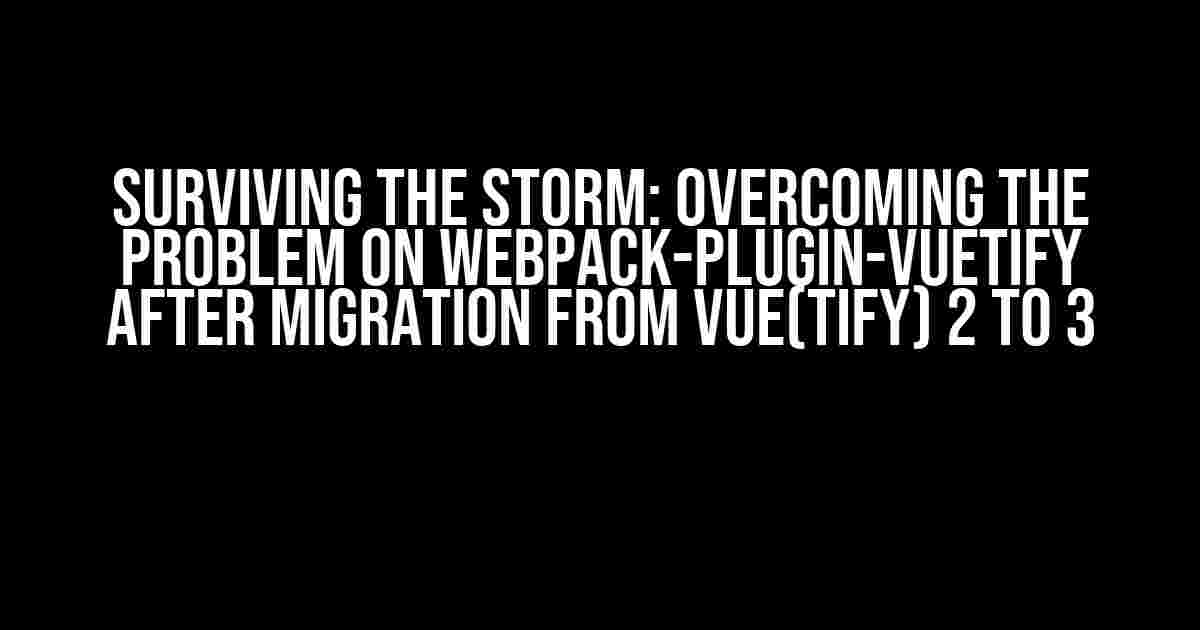Are you tired of banging your head against the wall, trying to fix the pesky issues with webpack-plugin-vuetify after migrating from Vue 2 to Vue 3? Fear not, dear developer, for you are not alone! In this article, we’ll embark on a journey to conquer the problem on webpack-plugin-vuetify and emerge victorious on the other side.
The Migration Conundrum
Upgrading from Vue 2 to Vue 3 can be a daunting task, especially when it comes to resolving issues with third-party libraries like Vuetify. The webpack-plugin-vuetify, specifically, can cause headaches due to its complex integration with the Vuetify framework. But don’t worry, we’ll break down the problem and its solution into manageable chunks.
What’s the Problem?
The issue with webpack-plugin-vuetify after migration arises from the changes in the Vuetify 3 architecture. In Vue 3, the composition API is the new norm, and Vuetify has adapted to this change. However, the webpack-plugin-vuetify is still stuck in the Vue 2 era, causing conflicts and errors.
ERROR in ./src/main.js
Module not found: Error: Can't resolve 'vue' in '/path/to/project/src'
Did you mean to import vue/dist/vue.cjs.js?
Yes, that dreaded error message. But fear not, we’ll get to the bottom of it.
The Solution
To overcome the problem on webpack-plugin-vuetify, we’ll need to update our configuration and dependencies. Follow these step-by-step instructions to resolve the issue:
-
Upgrade webpack-plugin-vuetify
Update your webpack-plugin-vuetify version to the latest one, which is compatible with Vue 3 and Vuetify 3.
npm install webpack-plugin-vuetify@latest -
Update Vuetify
Ensure you’re using the latest version of Vuetify, which is compatible with Vue 3.
npm install vuetify@latest -
Configure Webpack
In your webpack configuration file (usually `webpack.config.js`), add the following:
module.exports = { // ... resolve: { alias: { vue: 'vue/dist/vue.esm-bundler.js', }, }, plugins: [ new webpack.DefinePlugin({ __VUE_OPTIONS_API__: true, __VUE_PROD_DEVTOOLS__: false, }), ], }; -
Update main.js
In your `main.js` file, import Vuetify and create the app instance:
import { createApp } from 'vue'; import App from './App.vue'; import vuetify from './plugins/vuetify'; createApp(App).use(vuetify).mount('#app'); -
Create a Vuetify Plugin
Create a new file `plugins/vuetify.js` with the following content:
import { Vuetify } from 'vuetify'; import 'vuetify/dist/vuetify.css'; export default { install: (app) => { app.use(Vuetify); }, };
The Fix
With these steps, you should now have a working webpack-plugin-vuetify configuration that’s compatible with Vue 3 and Vuetify 3. The error messages should disappear, and your app should be up and running.
Common Pitfalls to Avoid
During the migration process, it’s easy to overlook some crucial details. Here are some common pitfalls to watch out for:
-
Forgetting to update dependencies: Make sure to update all dependencies, including webpack-plugin-vuetify and Vuetify, to the latest versions.
-
Mixing Vue 2 and Vue 3 syntax: Ensure that you’re not using Vue 2 syntax in your Vue 3 project. The composition API is the way to go in Vue 3.
-
Not configuring Webpack correctly: Double-check your Webpack configuration to ensure that it’s set up correctly for Vue 3 and Vuetify 3.
-
Not importing Vuetify correctly: Make sure to import Vuetify correctly in your main.js file and create the app instance with the Vuetify plugin.
Conclusion
Migrating from Vue 2 to Vue 3 can be a challenging task, but with the right guidance, you can overcome any obstacle. By following the steps outlined in this article, you should be able to resolve the problem on webpack-plugin-vuetify after migration from Vue 2 to Vue 3.
Remember to stay patient, persistent, and attentive to details. If you encounter any further issues, don’t hesitate to reach out to the Vue and Vuetify communities for support.
| Vue Version | Vuetify Version | webpack-plugin-vuetify Version |
|---|---|---|
| 2.x | 2.x | 1.x |
| 3.x | 3.x | 2.x |
By following the guidelines in this article, you’ll be able to navigate the complexities of migrating to Vue 3 and Vuetify 3, ensuring a seamless development experience.
Happy coding, and may the code be with you!
Frequently Asked Question
Are you stuck with webpack-plugin-vuetify after migrating from Vue 2 to 3? Don’t worry, we’ve got you covered! Check out these frequently asked questions to get back on track.
What’s the main issue with webpack-plugin-vuetify after migrating to Vue 3?
The main issue is that webpack-plugin-vuetify is not compatible with Vue 3, and it’s causing a lot of errors and headaches! Vue 3 has introduced significant changes to its architecture, and the plugin needs to be updated to accommodate these changes.
How do I fix the “Cannot read property ‘normalize’ of undefined” error?
This error usually occurs because the `vuetify-loader` is not compatible with Vue 3. To fix it, you need to upgrade to `vuetify-loader` version 2.0.0 or higher, which supports Vue 3.
What about the “Failed to resolve component” error?
This error usually occurs because Vue 3 has changed the way components are resolved. To fix it, you need to update your component imports to use the new `import { defineComponent } from ‘vue’;` syntax.
Do I need to update my Vuetify version as well?
Yes, you should update your Vuetify version to at least 3.0.0-beta.1, which is compatible with Vue 3. You can do this by running the command `npm install vuetify@next` or `yarn add vuetify@next`.
Is there a wiki or documentation that can help me with the migration?
Yes, the official Vuetify documentation has a comprehensive migration guide that can help you with the process. You can also check out the Vue 3 documentation and the webpack-plugin-vuetify GitHub page for more information.
